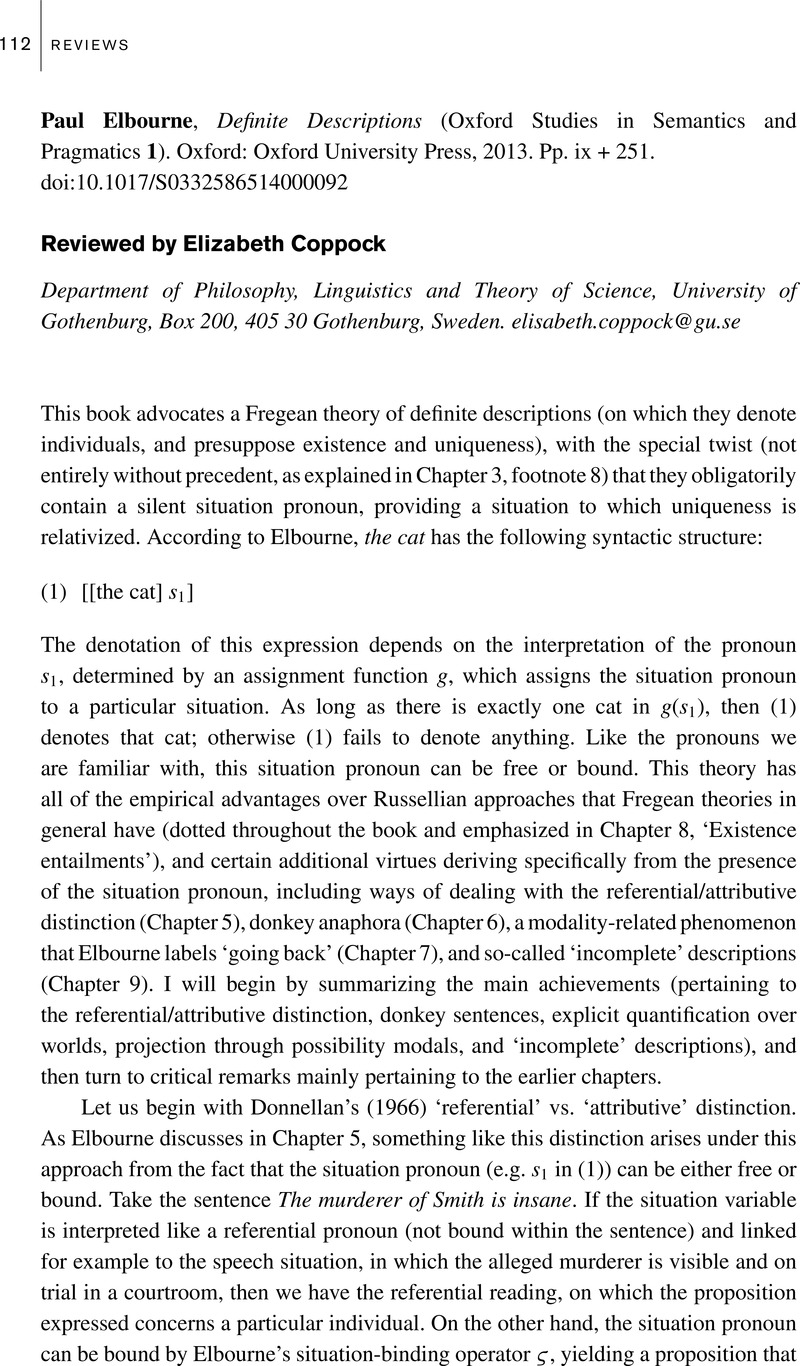No CrossRef data available.
Article contents
Paul Elbourne, Definite Descriptions (Oxford Studies in Semantics and Pragmatics 1). Oxford: Oxford University Press, 2013. Pp. ix + 251.
Published online by Cambridge University Press: 06 May 2014
Abstract
An abstract is not available for this content so a preview has been provided. Please use the Get access link above for information on how to access this content.

- Type
- Book Review
- Information
- Copyright
- Copyright © Nordic Association of Linguistics 2014
References
REFERENCES
Beaver, David & Krahmer, Emiel. 2001. A partial account of presupposition projection. Journal of Logic, Language and Information 10, 147–182.CrossRefGoogle Scholar
Coppock, Elizabeth & Beaver, David. 2012. Weak uniqueness: The only difference between definites and indefinites. In Chereches, Anca (ed.), 22nd Semantics and Linguistic Theory Conference (SALT 22), The University of Chicago, 18 May – 20 May 2012, 527–544. http://elanguage.net/journals/salt/issue/view/360.Google Scholar
Coppock, Elizabeth & Beaver, David. 2014. Definiteness and determinacy. Ms., University of Gothenburg & The University of Texas at Austin.Google Scholar
Donnellan, Keith S. 1966. Reference and definite descriptions. Philosophical Review 75 (3), 281–304.Google Scholar
Dowty, David, Wall, Robert E. & Peters, Stanley. 1981. Introduction to Montague Semantics. Dordrecht: Kluwer.Google Scholar
Fara, Delia Graff. 2001. Descriptions as predicates. Philosophical Studies 102, 1–42. [Originally published under the name Delia Graff.]Google Scholar
Haug, Dag. Partial dynamic semantics for anaphora: Compositionality without syntactic coindexation. Journal of Semantics, doi:10.1093/jos/fft008. Published online by Oxford University Press, 4 August 2013.Google Scholar
Heim, Irene. 1983. On the projection problem for presuppositions. In Flickinger, Daniel, Barlow, Michael & Westcoat, Michael (eds.), The Second West Coast Conference on Formal Linguistics (WCCFL 2), 114–125. Stanford, CA: Stanford University Press.Google Scholar
Heim, Irene & Kratzer, Angelika. 1998. Semantics in Generative Grammar. Oxford: Blackwell.Google Scholar
Kratzer, Angelika. 2010. Situations in natural language semantics. In Zalta, Edward (ed.), The Stanford Encyclopedia of Philosophy (Fall 2010 edition). Stanford, CA: CSLI. http://plato.stanford.edu/archives/fall2010/entries/situations-semantics/.Google Scholar
Lapierre, Serge. 1992. Partial functions in type theory. Notre Dame Journal of Formal Logic 33, 493–516.Google Scholar
Partee, Barbara H. 1986. Noun phrase interpretation and type-shifting principles. In Groenendijk, Jeroen, de Jongh, Dick & Stokhof, Martin (eds.), Studies in Discourse Representation Theory and the Theory of Generalized Quantifiers, 115–143. Dordrecht: Foris.Google Scholar
Schoubye, Anders J. 2009. Descriptions, truth value intuitions, and questions. Linguistics and Philosophy 32 (6), 583–617.Google Scholar
Schoubye, Anders J. 2012. Against the argument from convention. Linguistics and Philosophy 35 (6), 515–532.Google Scholar
Schoubye, Anders J. 2013. Ghosts, murderers, and the semantics of descriptions. Noûs 47 (3), 496–533.Google Scholar
Tichý, Pavel. 1982. Foundations of partial type theory. Reports on Mathematical Logic 14, 59–72.Google Scholar
Winter, Yoad. 2001. Flexibility Principles in Boolean Semantics. Cambridge, MA: MIT Press.Google Scholar




